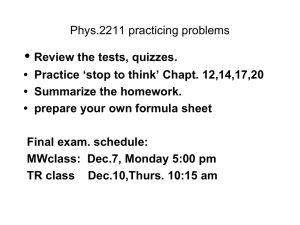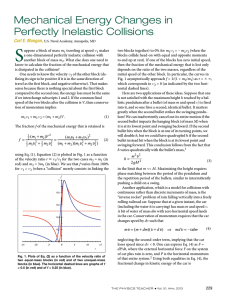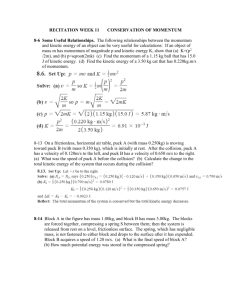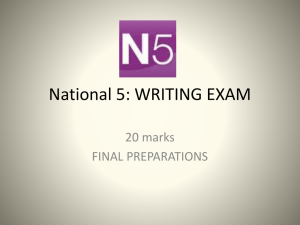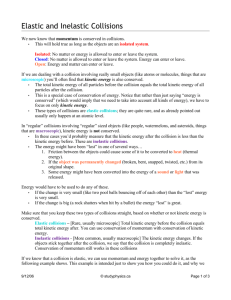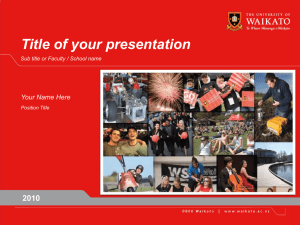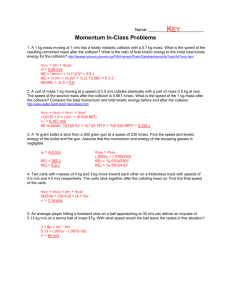Phys.2211 review guide
advertisement
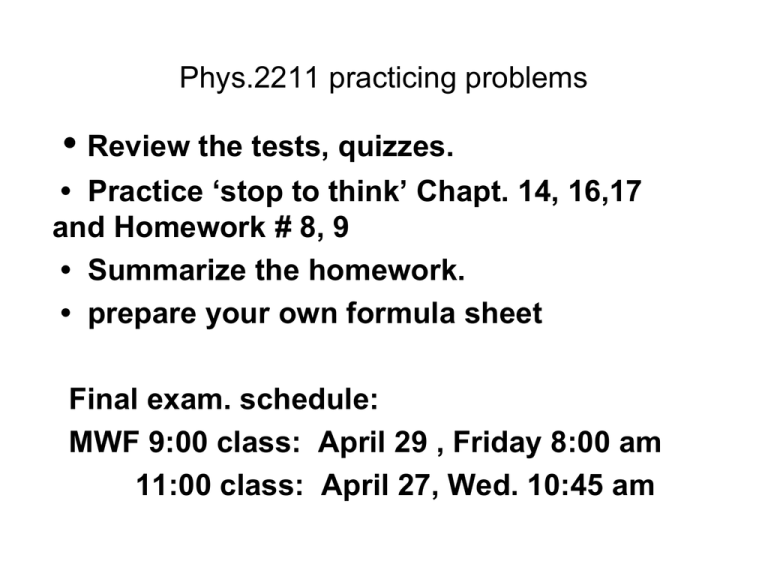
Phys.2211 practicing problems • Review the tests, quizzes. • Practice ‘stop to think’ Chapt. 14, 16,17 and Homework # 8, 9 • Summarize the homework. • prepare your own formula sheet Final exam. schedule: MWF 9:00 class: April 29 , Friday 8:00 am 11:00 class: April 27, Wed. 10:45 am comprehensive problems 1.You may use this way to get a bullet speed. Suppose a bullet of mass 8.00 g is fired into a block of mass 2.50 Kg initially at rest at the edge of a frictionless table of height 1.00m. The bullet remains in the block, and after impact the block lands a distance 2.00 m from the bottom of the table, Determine the initial speed of the bullet. (review perfectly inelastic collision and projectile motion. V(bullet) = 1388m/s) (2) A ball of mass m is attached to a string of length L. It is being swung in a vertical circle with enough speed so that the string remains taut throughout the ball's motion. • Find : • (1) Tb-Tt, the difference between the tension in the string at the bottom relative to that at the top of the circle in terms of m, g ( see your homework #7) • (2) find the centripetal acceleration difference at the bottom and the top 3. See the problem 10.42, ( at homework #7) suppose the collision between the packages is elastic (1) to what height does the package of mass m rebound? ( 1/3m) (2) what is the kinetic energy of the block of 2m, and what is the percentage of this kinetic energy to total kinetic energy? (8/9 = 89%) (3) if m and 2m stick together after collision, what is the kinetic energy left after collision.(1/3 mgh) 4. See the problem 12.71, (page 382 Homework #7), if we neglect the friction between m1 and table. The pulley mass is mp, (i) what is the acceleration of the system? (ii) If m2 start h (m) from the ground what is the speed when m2 hit the ground, ( b/c in this problem ,acceleration is a constant, so that you can use V2 = Vi2 + 2ah). (iii) you also can get that speed using mechanical energy conservation law. The results for two ways should be the same. 5. Santa Claus stands on the top of the hill, he is sending the Christmas gifts to you, a sphere, a cylinder, and circular hoop all of mass M and radius R. they are rolling down from rest at the same instant of time, which will get the bottom of the hill first? Why? • Please show the time for each one 6. • As you did in your lab for the ring pendulum, suppose this ring pendulum consists of a thin metal ring that can be suspended from a knife edge. a) What is the period if the ring diameter is 10 cm D (suppose the ring is very thin) T 2 g • b) If you plot log T vs log D( diameter) what is the slope? • c) If you had data from a lot of T and D, you may plot T2 vs D figure. how you use a slope to find the gravitational acceleration g? 7. See the figure: Can you increase the gas temperature without changing the pressure? If so, describe how you would do it. If not, explain why not. Answer: you can heat the gas on the bottom, but not add any mass on the piston, so mass maintains a constant pressure in the cylinder, but heat energy is transferred into the gas, makes temperature increase, as well as gas will expand from PΔV=nRΔT, you may get how much temperature increasing. This is constant pressure process, Q = nCp ΔT 8. 0.10 of a monatomic gas follows the process shown in the figure, how much heat energy is transferred to or from the gas during the process 1→2? (240J) how much heat energy is transferred to or from the gas during the process 2→3? (410J) What is the total change of thermal energy of the gas ( see homework #9, 17.59, you will find the molar specific heat of gases on page 524; table 17.4)
